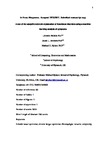A test of the adaptive network explanation of functional disorders using a machine learning analysis of symptoms.
| dc.contributor.author | Melidis, C | |
| dc.contributor.author | denham, susan | |
| dc.contributor.author | Hyland, ME | |
| dc.date.accessioned | 2018-01-10T13:12:35Z | |
| dc.date.available | 2018-01-10T13:12:35Z | |
| dc.date.issued | 2018-03 | |
| dc.identifier.issn | 0303-2647 | |
| dc.identifier.issn | 1872-8324 | |
| dc.identifier.uri | http://hdl.handle.net/10026.1/10546 | |
| dc.description.abstract |
The classification and etiology of functional disorders is controversial. Evidence supports both psychological and biological (disease) models that show, respectively, that functional disorders should be classified as one (bodily distress syndrome) and many (e.g., irritable bowel syndrome (IBS), fibromyalgia syndrome (FMS), and chronic fatigue syndrome (CFS)). Two network models (symptom network and adaptive network) can explain the specificity and covariation of symptomatology, but only the adaptive network model can explain the covariation of the somatic symptoms of functional disorders. The adaptive network model is based on the premise that a network of biological mechanisms has emergent properties and can exhibit adaptation. The purpose of this study was to test the predictions that symptom similarity increases with pathology and that network connection strengths vary with pathology, as this would be consistent with the notion that functional disorder pathology arises from network adaptation. We conducted a symptom internet survey followed by machine learning analysis. Participants were 1751 people reporting IBS, FMS or CFS diagnosis who completed a 61-item symptom questionnaire. Eleven symptom clusters were identified. Differences in symptom clusters between IBS, FMS and CFS groups decreased as overall symptom frequency increased. The strength of outgoing connections between clusters varied as a function of symptom frequency and single versus multiple diagnoses. The findings suggest that the pathology of functional disorders involves an increase in the activity and causal connections between several symptom causing mechanisms. The data provide support for the proposal that the body is capable of complex adaptation and that functional disorders result when rules that normally improve adaptation create maladaptive change. | |
| dc.format.extent | 22-30 | |
| dc.format.medium | Print-Electronic | |
| dc.language | en | |
| dc.language.iso | en | |
| dc.publisher | Elsevier | |
| dc.subject | Irritable bowel syndrome | |
| dc.subject | chronic fatigue syndrome | |
| dc.subject | complexity | |
| dc.subject | fibromyalgia | |
| dc.subject | network | |
| dc.title | A test of the adaptive network explanation of functional disorders using a machine learning analysis of symptoms. | |
| dc.type | journal-article | |
| dc.type | Journal Article | |
| plymouth.author-url | https://www.ncbi.nlm.nih.gov/pubmed/29278731 | |
| plymouth.volume | 165 | |
| plymouth.publication-status | Published online | |
| plymouth.journal | BioSystems | |
| dc.identifier.doi | 10.1016/j.biosystems.2017.12.010 | |
| plymouth.organisational-group | /Plymouth | |
| plymouth.organisational-group | /Plymouth/Faculty of Health | |
| plymouth.organisational-group | /Plymouth/REF 2021 Researchers by UoA | |
| plymouth.organisational-group | /Plymouth/REF 2021 Researchers by UoA/UoA04 Psychology, Psychiatry and Neuroscience | |
| plymouth.organisational-group | /Plymouth/Research Groups | |
| plymouth.organisational-group | /Plymouth/Research Groups/Centre for Brain, Cognition and Behaviour (CBCB) | |
| plymouth.organisational-group | /Plymouth/Research Groups/Centre for Brain, Cognition and Behaviour (CBCB)/Behaviour | |
| plymouth.organisational-group | /Plymouth/Research Groups/Centre for Brain, Cognition and Behaviour (CBCB)/Brain | |
| plymouth.organisational-group | /Plymouth/Users by role | |
| dc.publisher.place | Ireland | |
| dcterms.dateAccepted | 2017-12-19 | |
| dc.rights.embargodate | 2018-12-24 | |
| dc.identifier.eissn | 1872-8324 | |
| dc.rights.embargoperiod | Not known | |
| rioxxterms.versionofrecord | 10.1016/j.biosystems.2017.12.010 | |
| rioxxterms.licenseref.uri | http://www.rioxx.net/licenses/all-rights-reserved | |
| rioxxterms.licenseref.startdate | 2018-03 | |
| rioxxterms.type | Journal Article/Review |


